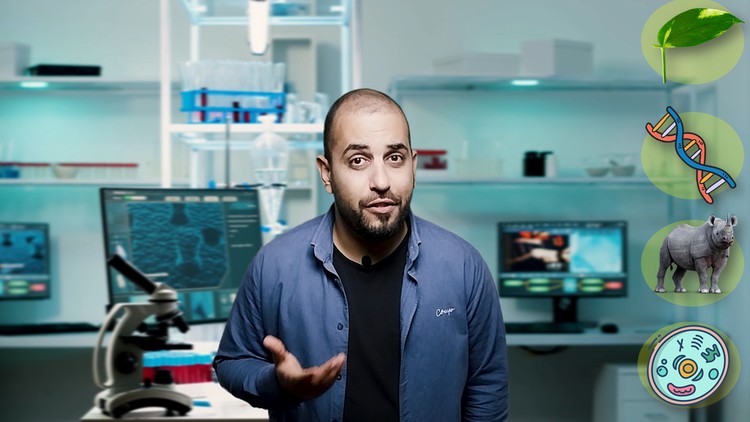IGCSE BIOLOGY: CIE O Level (complete course)
- Description
- Curriculum
- FAQ
- Reviews
This complete course in IGCSE Biology is designed to provide students with a comprehensive understanding of the key concepts and principles in the field of biology. Covering the complete syllabus for the Cambridge O Level IGCSE Biology, this course will equip students with the knowledge, skills, and practical experience necessary to succeed in their exams and beyond.
The course is designed with animations to make the learning experience more interactive and engaging. The animations allow students to see the biological concepts in action, which helps them to grasp the concepts more easily. The course materials also include a variety of multimedia resources, such as videos, interactive quizzes, and simulations, to help reinforce the concepts and make learning fun.
The course covers the full range of topics, including the study of cells, genetics, evolution, and ecology. Students will also learn about the human body, including the anatomy and physiology of the digestive, respiratory, circulatory, and nervous systems.
Throughout the course, students will engage in a range of practical activities, including experiments, data analysis, and fieldwork. These practical activities will allow students to develop important scientific skills, such as observing, predicting, and analyzing data.
Upon completion of the course, students will have a strong understanding of the fundamental principles of biology, as well as the skills and confidence necessary to excel in their exams and beyond.
If you have any inquiry, feel free to contact me on whatsapp through this number: +201021291511
-
1NOTES for chapter 1Text lesson
-
2Life processesVideo lesson
-
3SpeciesVideo lesson
-
4Classification and Binomial nomenclatureVideo lesson
-
5How to classify organisms?Video lesson
-
6Structure of the cell_ Plant vs animal cellVideo lesson
-
7Features and classfication of vertebratesVideo lesson
-
8Features and classification of invertebratesVideo lesson
-
9Eukaryotes vs prokaryotesVideo lesson
-
10Eukaryotes_ FungiVideo lesson
-
11Eukaryotes_ ProtistsVideo lesson
-
12Prokaryotes_ BacteriaVideo lesson
-
13VirusesVideo lesson
-
14Plant kingdomVideo lesson
-
15Specialized cells_ Ciliated cellsVideo lesson
-
16Specialized cells_ Nerve cellsVideo lesson
-
17Specialized cells_ Red blood cellsVideo lesson
-
18Specialized cells_ Sperm and ovumVideo lesson
-
19Specialized plant cells_ Palisade mesophyll and root hair cellVideo lesson
-
20Specialized plant cells_ Xylem cellVideo lesson
-
21Levels of organizationVideo lesson
-
22Plant organs and tissuesVideo lesson
-
23Animal organs and tissuesVideo lesson
-
24MagnificationVideo lesson
-
45Balanced dietVideo lesson
-
46Food groups and their functions and resourcesVideo lesson
-
47Vitamin CVideo lesson
-
48IronVideo lesson
-
49Varying dietary needsVideo lesson
-
50Diet deficiencies_ Scurvy and RicketsVideo lesson
-
51Stages of food breakdownVideo lesson
-
52Digestive systemVideo lesson
-
53AbsorptionVideo lesson
-
60Circulatory system and pathway of bloodVideo lesson
-
61Structure of the heartVideo lesson
-
62Difference between single and double circulationVideo lesson
-
63Monitoring the activity of the heartVideo lesson
-
64Coronary heart disease (CHD)Video lesson
-
65Blood vessels 1Video lesson
-
66Circulation around the body (Hepatic, ..)Video lesson
-
67Components of bloodVideo lesson
-
68Lymphocytes and phagocytesVideo lesson
-
69Blood clotting 1Video lesson
-
70Blood clotting 2Video lesson
-
78Gas exchange and respiration reactionVideo lesson
-
79Features of efficient gas exchange surfacesVideo lesson
-
80Gas exchange in alveoliVideo lesson
-
81Anatomy of respiratory systemVideo lesson
-
82Function of cartilage in tracheaVideo lesson
-
83Mechanism of breathing (exhalation and inhalation)Video lesson
-
84Investigating the difference between inspired and expired airVideo lesson
-
85Physical activity and breathing_ switching to anaerobic respirationVideo lesson

External Links May Contain Affiliate Links read more





